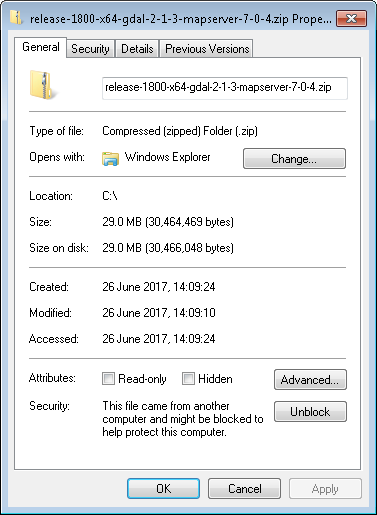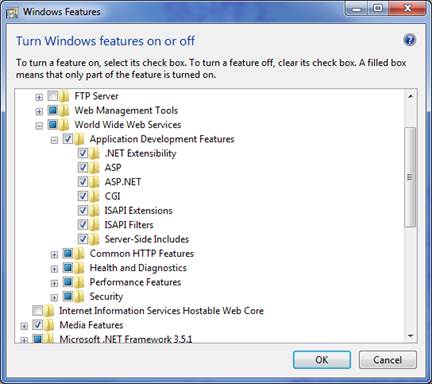IIS Setup for MapServer¶
- Author
Seth Girvin
- Contact
sgirvin at compass.ie
- Last Updated
2017-06-26
This document details how to configure a pre-built version of MapServer to run on IIS (Microsoft’s web server - Internet Information Services). These steps have a minimum requirement of IIS 7 and Windows 7, and should work for all release since up to IIS 10 and Windows 10.
MapServer can also be run on Windows using MS4W (MapServer for Windows) - which installs its own preconfigured Apache web server, and other related tools such as PHP, TinyOWS, and MapCache (which doesn’t currently run under IIS). Running MapServer under IIS may be necessary when deploying to servers where the installation of an additional web server is restricted, or where system administrators have more experience maintaining IIS.
Note
The MapServer executables from MS4W can also be used under IIS as well; for more information see the section in MS4W’s README, or ask the MS4W community for assistance (subscribe).
MapServer Setup¶
Precompiled versions of MapServer and GDAL (a required dependency) can be downloaded from http://www.gisinternals.com/release.php. These downloads are built and maintained by Tamas Szekeres a long term contributor to MapServer, and Project Steering Committee (PSC) member.
Note
Which version should I download?
Unless you are using deprecated features in your Mapfiles you should download the latest stable release.
Nearly all servers will now have a x64 (64-bit) architecture, so unless you are restricted to a win32 (32-bit) server download a x64 release.
Unless you have a good reason you should use the latest compiler version. MSVC 2013 means the binaries were compiled with using Visual C++ 2013. If you rely on Python2 Mapscript you will need to use the MSVC 2008 version so that it matches the version Python2 was compiled with.
This installation guide uses the “Compiled binaries in a single .zip package” download (release-1800-x64-gdal-2-1-3-mapserver-7-0-4). There is also a “MapServer installer with IIS registration support” option but at the time of writing this did not install successfully.
Once you have downloaded the zip file follow the steps below.
Unzip the folder to your machine. In this example we will assume it has been unzipped to
C:\MapServer. Make sure that have “unblocked” the zip, to avoid and security related issues later. Right-click on the zip file, select properties and click the “Unblock” button on the General tab.
Test that MapServer is working by double clicking
C:\MapServer\SDKShell.batto start a new Windows command session configured with MapServer environment settings, and then type:mapserv -v
The MapServer version and supported format types should be displayed in the command window.
Configuring with IIS¶
These steps assume IIS 7 or higher is installed on the development machine, and MapServer will use the default website
location at C:\Inetpub\wwwroot. All command line steps should be “Run as Administrator” (to select this option this right-click on the Windows command line icon).
Make sure IIS is on the machine - if you have a folder named C:\Inetpub then it is likely IIS is already installed.
First copy the required .exes into the same folder as the MapServer DLLs. This can be done using the command below:
xcopy C:\MapServer\bin\ms\apps\* C:\MapServer\bin
Create a new folder
C:\Inetpub\wwwroot\mapservermd C:\Inetpub\wwwroot\mapserverCreate a new, empty
C:\Inetpub\wwwroot\mapserver\web.configfile:Paste in the following configuration:
<?xml version="1.0" encoding="UTF-8"?> <configuration> <system.webServer> <handlers> <add name="MapServerFastCgi" path="*" verb="*" type="" modules="FastCgiModule" scriptProcessor="C:\Mapserver\bin\mapserv.exe" resourceType="Unspecified" requireAccess="Script" allowPathInfo="false" preCondition="" /> </handlers> <caching enabled="true" enableKernelCache="true" /> </system.webServer> </configuration>
Next set up the web application in IIS:
"%systemroot%\system32\inetsrv\appcmd" add app /site.name:"Default Web Site" /path:/mapserver /physicalPath:"C:\Inetpub\wwwroot\mapserver"
Next make sure the required ISAPI and CGI modules are installed in IIS with the following command:
start /w pkgmgr /iu:IIS-CGI;IIS-ISAPIExtensions;IIS-ISAPIFilter;Note
You can enable IIS modules through the useer interface as follows:
Click “Start button”
In the Search box, enter “Turn windows features on or off”
In the Features window, Click: “Internet Information Services”
Click: “World Wide Web Services”
Click: “Application Development Features”
Check (enable) the features.
IIS may then need to be restarted

Next we set the mapserver.exe to be a FastCGI application and allow it to run in IIS:
"%systemroot%\system32\inetsrv\appcmd" set config -section:system.webServer/fastCgi /+"[fullPath='C:\Mapserver\bin\mapserv.exe']" /commit:apphost "%systemroot%\system32\inetsrv\appcmd" set config /section:isapiCgiRestriction /+"[path='C:\MapServer\bin\mapserv.exe',description='MapServer',allowed='True']"
Test the setup was successful by entering the following URL in a browser: http://localhost/mapserver/. If the following text is displayed then MapServer has been successfully configured as a FastCGI application in IIS.
No query information to decode. QUERY_STRING is set, but empty.
Setting up Applications¶
MapServer applications consist of a Mapfile, and additional optional files for data, symbols, logs, and images. The same instance of MapServer
can be used to serve many applications. In this example we will create a new test subfolder for a test application in a C:\MapServer\apps folder.
md C:\MapServer\apps\test
Now create a new test.map file in this folder and paste in the test Mapfile below.
MAP
EXTENT -180 -90 180 90
# Set the path to where the map projections are stored
CONFIG "PROJ_LIB" "C:\MapServer\bin\proj\SHARE"
NAME "TestMap"
WEB
METADATA
"ows_enable_request" "*"
END
END
PROJECTION
"init=epsg:4326"
END
LAYER
NAME "country_bounds"
TYPE RASTER
CONNECTION "https://demo.mapserver.org/cgi-bin/wms?"
CONNECTIONTYPE WMS
METADATA
"wms_srs" "EPSG:4326"
"wms_name" "country_bounds"
"wms_server_version" "1.1.1"
"wms_format" "image/gif"
END
END
END
You should now be able to test the application is accessible through IIS using the following URL to retrieve an image via WMS: http://localhost/mapserver/mapserv?map=C:/MapServer/apps/test/test.map&SERVICE=WMS&VERSION=1.3.0&REQUEST=GetMap&LAYERS=country_bounds&STYLES=&CRS=EPSG:4326&BBOX=-180,-90,180,90&WIDTH=400&HEIGHT=300&FORMAT=image/png
Setting up Logging¶
You can setup MapServer logging by adding the following lines to your MAP block.
DEBUG 5 # a value from 0 (OFF) to 5 (detailed)
CONFIG "MS_ERRORFILE" "logs\ms.log"
The path to the log file is relative to the Mapfile, so in this example you need to create a new C:\MapServer\apps\test\logs folder:
md C:\MapServer\apps\test\logs
You will then need to set read-write permissions on the log file to the IIS application pool user (in this example we are using the default IIS AppPool\DefaultAppPool account
that the MapServer FastCGI runs under):
icacls "C:\MapServer\apps\test\logs" /grant "IIS AppPool\DefaultAppPool":(OI)(CI)RW
If a different application pool is used, or you don’t set the permissions you will receive the following message
(also check that the C:\MapServer\apps\test\logs folder exists as it will not be created automatically).
msSetErrorFile(): General error message. Failed to open MS_ERRORFILE C:/MapServer/apps/test/logs/ms.log
Troubleshooting¶
Check that the file exists if you receive the following error. If it does exist then check the file permissions.
msLoadMap(): Unable to access file. (C:/MapServer/apps/test/test.map)
MapServer projections are stored in
C:\MapServer\bin\proj\SHARE. When the projection is specified in the following form"init=epsg:3857", MapServer will try to find this code in theepsgfile, where it is listed as<3857> +proj=merc +a=6378137.... If you receive the error below then make sure theCONFIG "PROJ_LIB" "C:\MapServer\bin\proj\SHARE"setting is pointing to the correct path. Note on one installation this message was shown as forward slashes rather than backslashes were used.msProcessProjection(): Projection library error. proj error "No such file or directory" for "init=epsg:3857"
The following error is caused if IIS has been locked-down so settings cannot be overridden at the
web.configlevel.HTTP Error 500.19 - Internal Server Error The requested page cannot be accessed because the related configuration data for the page is invalid. This configuration section cannot be used at this path. This happens when the section is locked at a parent level. Locking is either by default (overrideModeDefault="Deny"), or set explicitly by a location tag with overrideMode="Deny" or the legacy allowOverride="false".
Run the following in a command window (with administrator permissions). This enables the handlers section in the /mapserver/web.config file to override the ones set at the machine level. See http://stackoverflow.com/questions/9794985/iis-this-configuration-section-cannot-be-used-at-this-path-configuration-lock
%windir%\system32\inetsrv\appcmd.exe unlock config -section:system.webServer/handlersCheck
C:\MapServer\bin\mapserv.exeexists if you encounter the error below.HTTP Error 500.0 - Internal Server Error The FastCGI executable could not be found
To view the CGI applications registered with IIS you can use the command below (this reads the
C:\Windows\System32\inetsrv\config):"%systemroot%\system32\inetsrv\appcmd" list config /section:isapiCgiRestriction
This should output XML similar to below for this section:
<system.webServer> <security> <isapiCgiRestriction> <add path="C:\MapServer\bin\mapserv.exe" allowed="true" description="MapServer" /> </isapiCgiRestriction> </security> </system.webServer>
